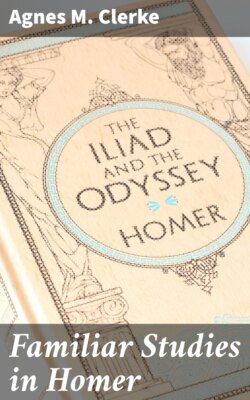Familiar Studies in Homer

Реклама. ООО «ЛитРес», ИНН: 7719571260.
Оглавление
Agnes M. Clerke. Familiar Studies in Homer
Familiar Studies in Homer
Table of Contents
PREFACE
CHAPTER I. HOMER AS A POET AND AS A PROBLEM
CHAPTER II. HOMERIC ASTRONOMY
CHAPTER III. THE DOG IN HOMER
CHAPTER IV. HOMERIC HORSES
CHAPTER V. HOMERIC ZOOLOGY
CHAPTER VI. TREES AND FLOWERS IN HOMER
CHAPTER VII. HOMERIC MEALS
CHAPTER VIII. HOMER’S MAGIC HERBS
CHAPTER IX. THE METALS IN HOMER
CHAPTER X. HOMERIC METALLURGY
CHAPTER XI. AMBER, IVORY, AND ULTRAMARINE
Отрывок из книги
Agnes M. Clerke
Published by Good Press, 2021
.....
The plastic art of Mycenæ seems to have been on the decline when the ‘sovran poet’ arose. This can be inferred from the wondering admiration displayed in his verses for what must once have been its ordinary performances, as well as from the marked superiority assigned in them to foreign over native artists. They include besides no allusion to the signet-rings so plentiful at Mycenæ, no notice, in any connexion, of the art of gem-engraving, nor of the indispensable luxury—to ladies of high degree—of toilet-mirrors. Active intercourse with Egypt, again, had evidently ceased long prior to the Homeric age. The Nile is, in the poems, not even known by name, but only as the ‘river of Egypt;’ and the country is reached, not in the ordinary course of navigation, but through recklessness or ill-luck, by adventurers or castaways.
We can now gather the following indications regarding the date of the Homeric poems. They must have originated during the interval between the Trojan War—which, in some shape, may be accepted as an historical event—and the Dorian invasion of the Peloponnesus. They probably originated not very long before the latter event, when the Mycenæan monarchy was of itself tottering towards a fall precipitated by the frequently repeated incursions of ruder tribes from the north. The generally accepted date for the final event is eighty years after the taking of Troy, or 1104 B.C. But this rests on no authentic circumstance, and may very well be a century or more in error. A preferable chronological arrangement would place Homer’s flourishing in the eleventh century, and the overthrow of Mycenæ near its close. Difficulties of sundry kinds can thus be, in a measure, evaded or conciliated, without encroaching overmuch on the voiceless centuries available for the unrecorded readjustment of the disturbed elements of Greek polity.
.....